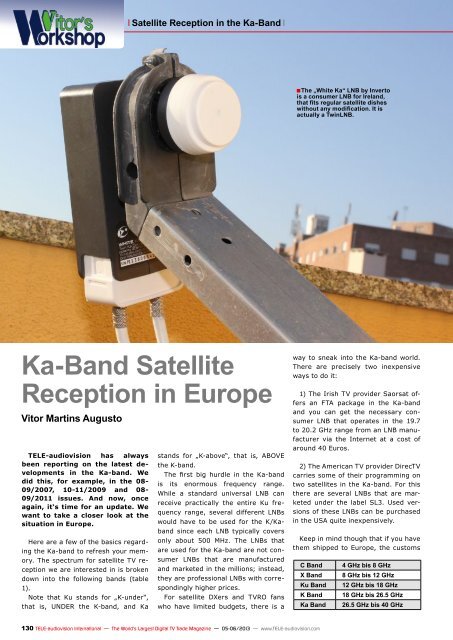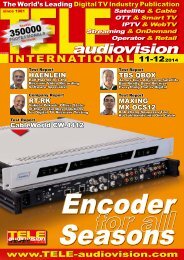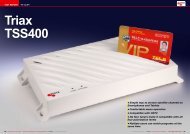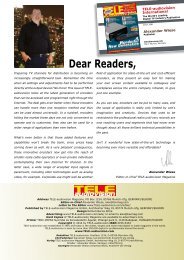eng TELE-audiovision 1305
The World’s Largest Digital TV Trade Magazine
The World’s Largest Digital TV Trade Magazine
You also want an ePaper? Increase the reach of your titles
YUMPU automatically turns print PDFs into web optimized ePapers that Google loves.
<strong>TELE</strong>-<strong>audiovision</strong> has always<br />
been reporting on the latest developments<br />
in the ka-band. We<br />
did this, for example, in the 08-<br />
09/2007, 10-11/2009 and 08-<br />
09/2011 issues. And now, once<br />
again, it‘s time for an update. We<br />
want to take a closer look at the<br />
situation in Europe.<br />
Here are a few of the basics regarding<br />
the Ka-band to refresh your memory.<br />
The spectrum for satellite TV reception<br />
we are interested in is broken<br />
down into the following bands (table<br />
1).<br />
Note that Ku stands for „K-under“,<br />
that is, UNDER the K-band, and Ka<br />
Satellite Reception in the Ka-Band<br />
Ka-Band Satellite<br />
Reception in Europe<br />
vitor Martins Augusto<br />
stands for „K-above“, that is, ABOVE<br />
the K-band.<br />
The first big hurdle in the Ka-band<br />
is its enormous frequency range.<br />
While a standard universal LNB can<br />
receive practically the entire Ku frequency<br />
range, several different LNBs<br />
would have to be used for the K/Kaband<br />
since each LNB typically covers<br />
only about 500 MHz. The LNBs that<br />
are used for the Ka-band are not consumer<br />
LNBs that are manufactured<br />
and marketed in the millions; instead,<br />
they are professional LNBs with correspondingly<br />
higher prices.<br />
For satellite DXers and TVRO fans<br />
who have limited budgets, there is a<br />
130 <strong>TELE</strong>-<strong>audiovision</strong> International — The World‘s Largest Digital TV Trade Magazine — 05-06/2013 — www.<strong>TELE</strong>-<strong>audiovision</strong>.com<br />
■<br />
The „White Ka“ LnB by Inverto<br />
is a consumer LnB for Ireland,<br />
that fits regular satellite dishes<br />
without any modification. It is<br />
actually a TwinLnB.<br />
way to sneak into the Ka-band world.<br />
There are precisely two inexpensive<br />
ways to do it:<br />
1) The Irish TV provider Saorsat offers<br />
an FTA package in the Ka-band<br />
and you can get the necessary consumer<br />
LNB that operates in the 19.7<br />
to 20.2 GHz range from an LNB manufacturer<br />
via the Internet at a cost of<br />
around 40 Euros.<br />
2) The American TV provider DirecTV<br />
carries some of their programming on<br />
two satellites in the Ka-band. For this<br />
there are several LNBs that are marketed<br />
under the label SL3. Used versions<br />
of these LNBs can be purchased<br />
in the USA quite inexpensively.<br />
Keep in mind though that if you have<br />
them shipped to Europe, the customs<br />
c Band 4 GHz bis 8 GHz<br />
x Band 8 GHz bis 12 GHz<br />
Ku Band 12 GHz bis 18 GHz<br />
K Band 18 GHz bis 26.5 GHz<br />
Ka Band 26.5 GHz bis 40 GHz


















